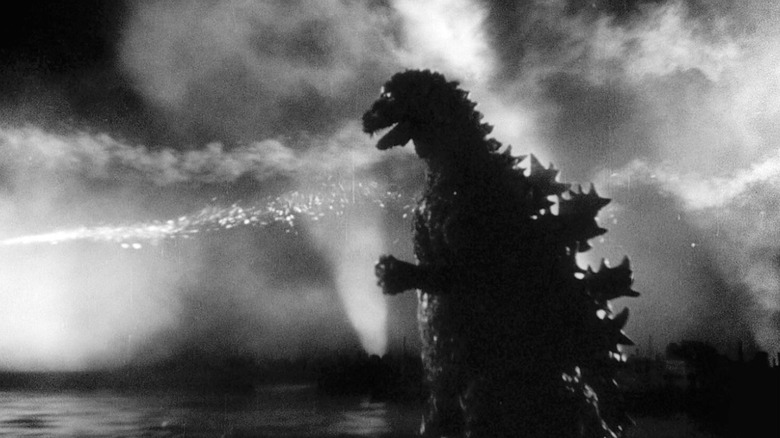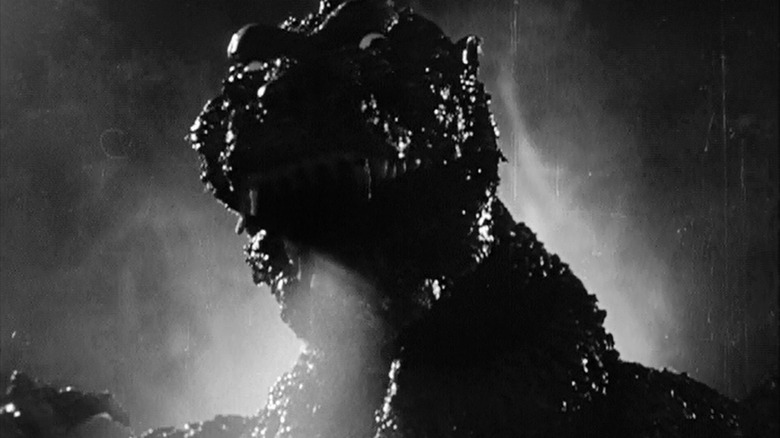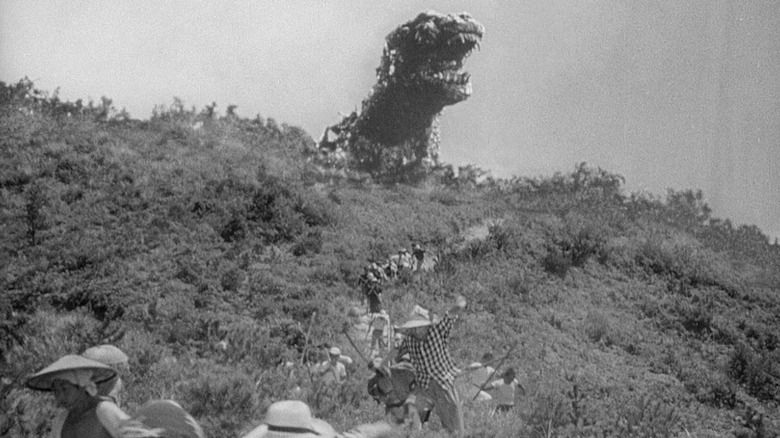What The Harshest Critics Had To Say About 1954's Godzilla
The original Japanese version of Ishiro Honda's kaiju classic "Gojira" — previously bowdlerized by American translators as "Godzilla" — wasn't released in American theaters until 2004 to coincide with the film's 50th anniversary. Up until then, American audiences had to content themselves with the 1956 film "Godzilla, King of the Monsters!," a heavily re-edited version of "Gojira" that included new scenes of actor Raymond Burr narrating the action. The footage was directed by Terry O. Morse ("Unknown World," "Taffy and the Jungle Hunter").
When "Gojira" was finally released in 2004, not every critic was pleased. Most audiences accepted that Honda's film more or less birthed the kaiju genre, and established a persistent pop culture icon that persists to this day. Roger Ebert acknowledged that "Gojira" could be significant while also being completely shabby. He gave the film only one and a half stars, saying it was "idiotic." "Godzilla at times looks uncannily like a man in a lizard suit," he wrote, "stomping on cardboard sets, as indeed he was, and did. Other scenes show him as a stuffed, awkward animatronic model. This was not state of the art even at the time; 'King Kong' (1933) was much more convincing." He concluded by saying, "This is a bad movie, but it has earned its place in history."
That may seem unduly harsh, but Ebert was only the most recent critic to lambaste Honda's film. In Peter H. Brothers' book "Atomic Dreams and the Nuclear Nightmare: The Making of Godzilla," the author culled vintage newspapers printed in the wake of "Gojira," and found that many critics — in both Japan and elsewhere — were not kind to Honda's film. Here are some samples of what he found.
The original reviews for Godzilla
In the November 3, 1954 edition of the Yomiuri Evening Shimbun, the critic noted that "Gojira" had some fun special effects, but little else. "Post-war special effects techniques in Japanese film are in revival, and the behind-the-scenes efforts of this development should be praised." But, the critic continued, Godzilla himself wasn't a very interesting monster. They wrote:
"One of the drawbacks is that Godzilla has no personality. With King Kong there was some charm in the movements; it was oozing with the drama of being bewildered by a world with a different environment. The destruction itself was not with evil intent. But Godzilla is brusque and blunt. There's not one ounce of the tragedy of losing a peaceful habitat due to a hydrogen bomb test coming across."
The critic also noted that the human drama in "Gojira" was "truly poor," and that the science was complete bunk. "The special effects are the only redeeming feature."
Meanwhile, in the Asahi Arts evening edition from the same day, the resident critic felt that "Gojira" didn't rise above similarly corny giant-animal films being made in the United States. "Such science films are rare in Japan," the critic noted positively. "Having said that, there's not that much more entertainment in this fantasy film either."
The critic went on to note that "Gojira" is indeed tapping into the palpable nuclear fear felt by Japanese citizens ... but that the monster kinda sucks. They wrote:
"Specifically, with the monster Godzilla, you cannot disregard the fact that it lacks a thing called 'personality' which significantly weakens the entertainment factor. Compared with the likes of 'King Kong' there are some interesting moments, but it cannot possibly reach the intensity of the ants in 'Them!.'"
"Gojira" wasn't as good as "Them!". Pretty harsh.
Other early Godzilla reviews
The Asahi Arts critic did note, however, that the design of Godzilla was astonishing and that it will most assuredly be popular. That critic certainly called it.
A newspaper called the Current News felt that the science of "Gojira" was shabby to the point of absurdity, writing:
"Even though Godzilla is a product of the imagination, along with the manner of the monster and the means to conquer it, the science behind these shouldn't be stretched; what's left is an aftertaste like a comedic farce. And here is the difference in skill between Japan and America: the shabbiness of the scientific fantasy becomes the weak point."
Another local critic felt that American monster movies had already outstripped what "Gojira" was trying to do. "Eiji Tsuburaya's special effects are fairly enjoyable and the tricks will please children." While the final part cannot be argued — little kids like Godzilla movies — it hurts to see a classic so roundly dismissed. The Current News critic also felt that the film's messages about protecting Godzilla and preserving the natural world were a very small, almost insignificant element of the movie and that they weren't well-communicated besides.
These days, "Gojira" is well-regarded, and the film boasts a 94% approval rating on Rotten Tomatoes. Even the positive reviews cite the film's hit-and-miss acting and silly plot. The negative reviews, meanwhile, fall in line with Ebert, with various critics pointing to the creaky visuals, the slow pace, and the ridiculous science.
Godzilla, of course, will always have the last word, as he continues to live on. The most recent Godzilla movie was released just a few months ago.


